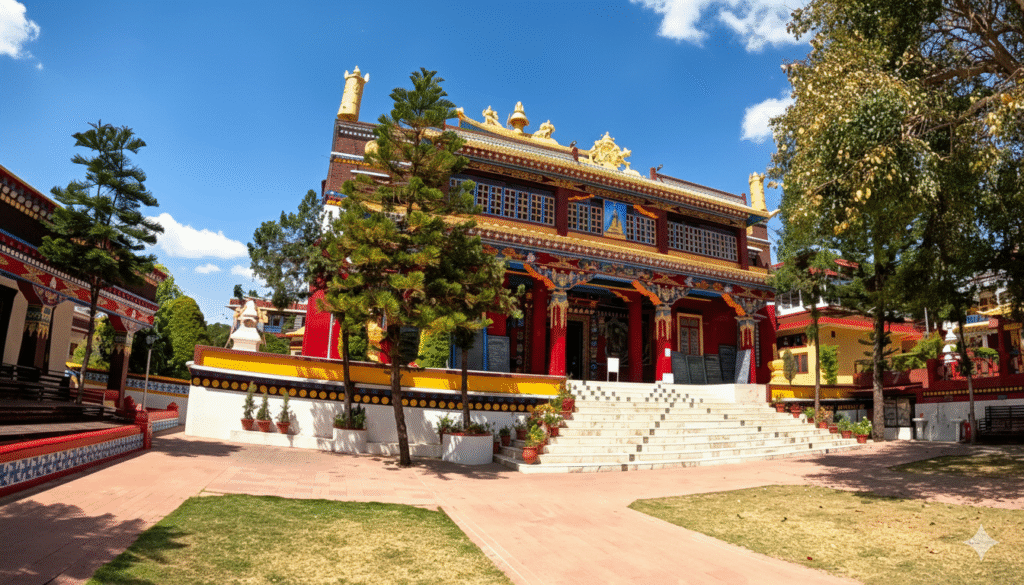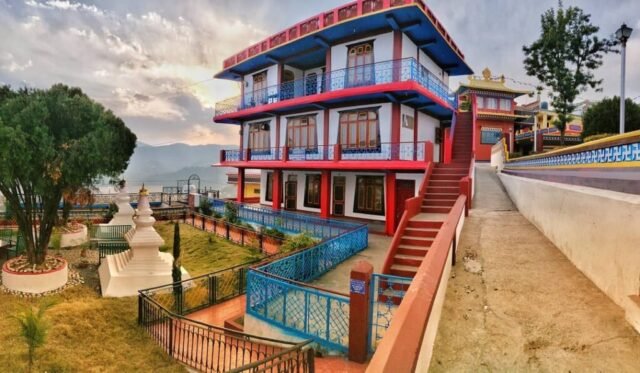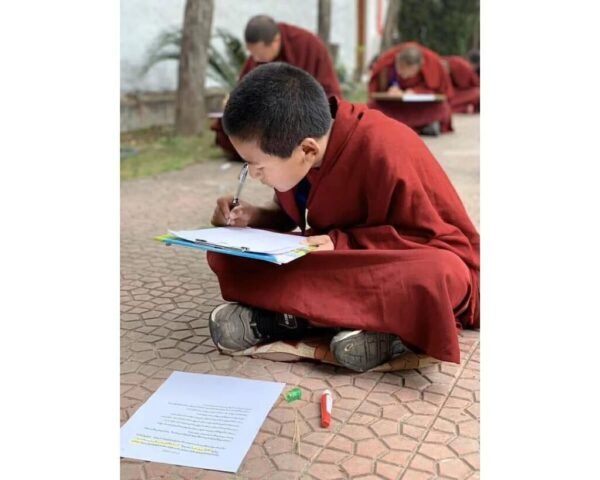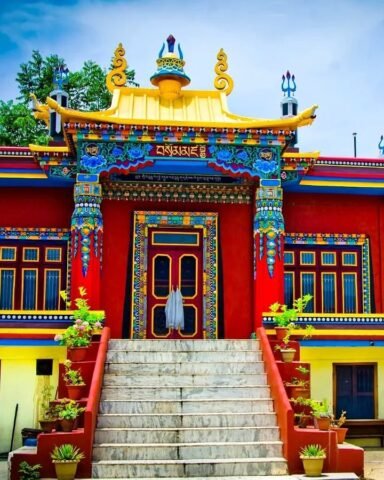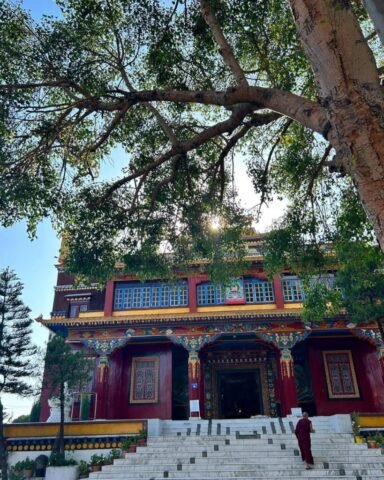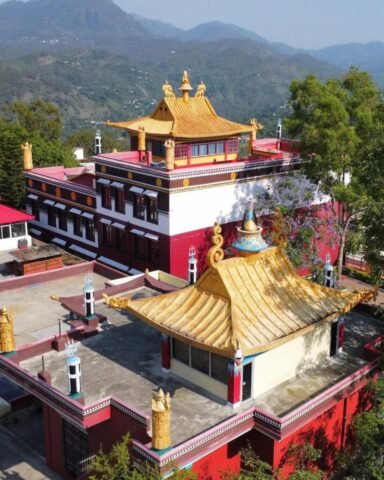Introduction
In the serene Dolanji hills, just a few kilometers away from Solan town, rests the Bon Monastery, counted among the most unique spiritual treasures on earth. Known as the principal seat of the Bon religion outside Tibet, Bon Menri Monastery has become not only a spiritual centre but also a symbol of resilience, preserving one of the oldest religious traditions of Tibet that predates Buddhism itself.
Established in 1967 after the destruction of the original Menri Monastery in Tibet, this sacred place has today grown into a vibrant centre of learning, prayer, and cultural preservation. For those who are seeking peace, spiritual connection, or simply an understanding of Tibet’s lesser-known Bon religion, Bon Menri Monastery offers an unforgettable experience.
In this blog, we will take you through the history of Bon religion, the architecture of the Bon Menri Monastery, its spiritual importance, festivals, visitor guide, nearby attractions, and our personal experience of visiting Dolanji’s Bon Menri Monastery.
The History of Bon and Bon Menri Monastery
The Bon religion is often described as Tibet’s oldest spiritual tradition. According to legend, it was founded nearly 18,000 years ago by Tonpa Shenrab Miwoche, long before Buddhism arrived in Tibet.The Bon spiritual path covers a wide spectrum – from rituals and meditation to healing, astrology, and the worship of nature and deities.
For centuries, the Menri Monastery in Tibet was the central seat of Bon. However, during the Chinese invasion of Tibet in 1959, Menri Monastery was destroyed, and the survival of Bon tradition came under threat.
In 1967, two great Bon masters – His Holiness Lungtok Tenpai Nyima, the 33rd Menri Trizin (spiritual head of Bon), and Lopon Tenzin Namdak Rinpoche, The monastery was re-established in Dolanji, Himachal Pradesh, by one of the most esteemed masters of Bon tradition.. This new Menri became the world headquarters of Bon religion in exile, ensuring that the ancient Bon teachings and practices would continue to thrive.
Since then, Bon Menri Monastery has not only preserved Bon scriptures and rituals but also trained hundreds of monks and nuns from across the world, becoming a beacon of Tibetan culture in India.
Architecture & Design of Bon Menri Monastery
One of the first things that captures your attention at Bon Menri Monastery is its majestic Tibetan-style architecture. The monastery stands tall against the backdrop of Himachal’s pine-covered hills, glowing with golden rooftops and brightly painted walls.
Key Architectural Features:
Golden Roofed Temple: The main shrine hall is adorned with golden roofs, symbolic of spiritual purity and enlightenment.

Prayer Hall: Inside, you will find a huge prayer hall decorated with colourful murals and frescoes depicting Bon deities, sacred symbols, and cosmological diagrams. The hall also houses a large statue of Tonpa Shenrab, the founder of Bon religion.

Prayer Wheels: Rows of large prayer wheels engraved with Bon mantras are placed around the monastery. Spinning these wheels while chanting is believed to bring blessings.
Monk Quarters & Study Halls: The complex includes living quarters, classrooms, and a library where monks study philosophy, meditation, astrology, and medicine.
Courtyards & Flags: Open courtyards lined with fluttering prayer flags create an atmosphere of peace, blending spirituality with nature.
Walking through the monastery, one can clearly see how the architecture reflects both aesthetic beauty and deep spiritual meaning.
Spiritual Importance of Bon Menri Monastery
Bon Menri Monastery is more than a place of worship; it stands as the heart of Bon philosophy and education in today’s world. It also serves as the principal training center for Bon monks and nuns across the globe.
Ancient Bon texts, many of which were rescued from Tibet, are preserved here in the monastery’s library.
Monks are trained in rituals, astrology, meditation, tantric practices, healing traditions, and philosophy.
Daily prayers and chanting rituals fill the air with divine energy, making visitors feel instantly calm and spiritually uplifted.
For Bon followers across the globe, this monastery is their Vatican – the ultimate place of faith and learning.
What makes Bon unique is its deep respect for nature, spirits, and cosmic balance. This philosophy is reflected in the rituals and teachings at Dolanji’s Bon Menri.
Festivals & Rituals at Bon Menri Monastery
Visiting during a festival brings the monastery alive with colours, music, and sacred energy.
Cham Dance Festival – Monks dressed in elaborate masks and costumes perform ritual dances that symbolize the triumph of good over evil. The slow, rhythmic movements accompanied by drums and horns leave visitors mesmerized.
Losar (Tibetan New Year)-The monastery celebrates Tibetan New Year with grand rituals, prayers for peace, and cultural programs.
Annual Prayer Ceremonies– Special rituals are conducted to ensure world peace, prosperity, and harmony.
These events are not just spiritual gatherings but also cultural spectacles that attract people from India and abroad.
How to Reach Bon Menri Monastery
By Road: Dolanji is located about 15 km from Solan town, 61 km from Shimla, and 80 km from Chandigarh. Taxis and buses are available.
By Train: The nearest station is Solan Railway Station (on the Kalka–Shimla line). From there, taxis can be hired.
By Air: The nearest airport is Chandigarh International Airport (91 km).
The drive from Solan to Dolanji is particularly scenic, with winding roads through forests and valleys. The last part of the road is a bit narrow, so if you are driving on that stretch, please drive slowly.
Visitor Information
Timings: Open daily from 6:00 AM to 6:00 PM.
Entry Fee: Free for all visitors. Donations are welcome.
Best Time to Visit: October to March (clear skies and pleasant weather). Monsoon months make the area green but roads may be slippery.
Tips for Visitors:
Maintain silence and respect during prayers.
Photography may be restricted inside prayer halls. Please maintain silence and avoid making noise. .
Take time to spin the prayer wheels and sit in silence to feel the energy.
Nearby Attractions
Shoolini Mata Temple: The spiritual heart of Solan, dedicated to Goddess Shoolini. The annual Shoolini Fair turns the town into a lively celebration of devotion, colors, and traditions.
Jatoli Shiv Mandir: Asia’s tallest Shiva temple, built in traditional Dravidian style. From its hilltop perch, it offers breathtaking views and a deeply peaceful spiritual aura.
Mohan Shakti Heritage Park: A 40-acre cultural marvel filled with majestic sculptures, beautifully landscaped gardens, and mythological depictions that bring India’s heritage to life.
Nauni University (Dr. Y.S. Parmar University of Horticulture and Forestry): A renowned hub of learning and research where students from across India study horticulture, forestry, and allied sciences. The lush green campus itself is a treat to explore.
Kasauli & Barog: Picturesque colonial-era hill towns offering misty landscapes, charming trails, toy train rides, and stunning sunsets — a perfect escape into nature and nostalgia.
Our Experience at Bon Menri Monastery
The moment we arrived at Bon Menri Monastery in Dolanji, what struck us most was its profound calmness. The sound of monks chanting carried across the valley, while colourful prayer flags fluttered in the Himalayan breeze. The golden rooftops of this Tibetan-style monastery in India shone against the backdrop of blue sky and green hills, creating a truly magical sight.
Inside the main prayer hall, the towering statue of Tonpa Shenrab, founder of the Bon religion in Tibet and India, stood surrounded by vibrant murals depicting Bon deities and sacred symbols. Monks sat in rows, reciting scriptures with deep focus. The vibration of their chants created a meditative energy that we could feel in our hearts.
We also walked around the prayer wheels of Bon Menri Monastery, turning them slowly while whispering prayers. Each spin felt like connecting to centuries of Bon traditions preserved in Himachal Pradesh.
Meeting some of the monks was another highlight. They shared how Bon Menri is not only about rituals, but also about education, healing practices, astrology, and preserving ancient Tibetan heritage. Their humility and warmth touched us deeply.
For us, visiting Bon Menri Monastery was more than a travel experience – it was a soulful journey into one of the world’s oldest spiritual traditions and the living world headquarters of Bon outside Tibet.
Bon Menri Monastery Location, Photos & Videos
YouTube Video:Coming soon on – KKSB Vlogs
Instagram Updates: Stay connected with us for reels and updates– @official_kksb
Photos Of Bon Monastery
Location Of Bon Monastery
FAQs about Bon Menri Monastery
What is Bon Menri Monastery famous for?
Bon Menri Monastery in Dolanji is the principal Bon monastery outside Tibet. It is famous for preserving one of the world’s oldest spiritual traditions, Tibetan-style architecture, colourful murals, prayer wheels, and serving as the world headquarters of Bon religion in India.
Who founded Bon Menri Monastery in Dolanji?
The monastery was re-established in 1967 by His Holiness Lungtok Tenpai Nyima, the 33rd Menri Trizin, along with Lopon Tenzin Namdak Rinpoche. It became the spiritual centre of Bon after the original Menri Monastery in Tibet was destroyed.
Where is Bon Menri Monastery located?
It is located in Dolanji village, about 15 km from Solan town, Himachal Pradesh. Surrounded by pine forests, it lies within driving distance of Shimla and Chandigarh, making it an accessible yet peaceful spiritual retreat.
What is the best time to visit Bon Menri Monastery?
The best time to visit is between October and March, when skies are clear and the weather is pleasant. Summers are also comfortable, while monsoon months make the valley lush green but roads can be slippery.
Can tourists visit Bon Menri Monastery?
Yes, tourists are welcome. Visitors can attend morning or evening prayers, explore the prayer hall and murals, spin the prayer wheels, and interact with monks to learn about the Bon religion in Himachal Pradesh.
What festivals are celebrated at Bon Menri Monastery?
The monastery celebrates the Cham Dance Festival, where monks perform sacred masked dances, Losar (Tibetan New Year), and annual prayer ceremonies. These festivals attract both locals and international visitors.
Is there an entry fee for Bon Menri Monastery?
There is no entry fee to visit Bon Menri Monastery. However, visitors may give voluntary donations that support the education of monks, preservation of Bon scriptures, and upkeep of the monastery.
How old is the Bon religion practiced at Bon Menri Monastery?
The Bon religion is considered Tibet’s oldest tradition, believed to be founded by Tonpa Shenrab Miwoche nearly 18,000 years ago, long before Buddhism reached Tibet.
What can visitors see inside Bon Menri Monastery?
The inner sanctum of Bon Menri reveals a beautifully adorned prayer hall, filled with colourful wall paintings, shelves of ancient Bon texts, and the powerful presence of monks reciting prayers before the grand image of Tonpa Shenrab. The prayer wheels and fluttering prayer flags add to the monastery’s charm.
Why is Bon Menri Monastery important for Himachal Pradesh tourism?
Bon Menri Monastery is one of the unique spiritual attractions in Solan district, offering cultural, historical, and spiritual experiences. It attracts international visitors and makes Dolanji a must-visit destination for heritage tourism.

